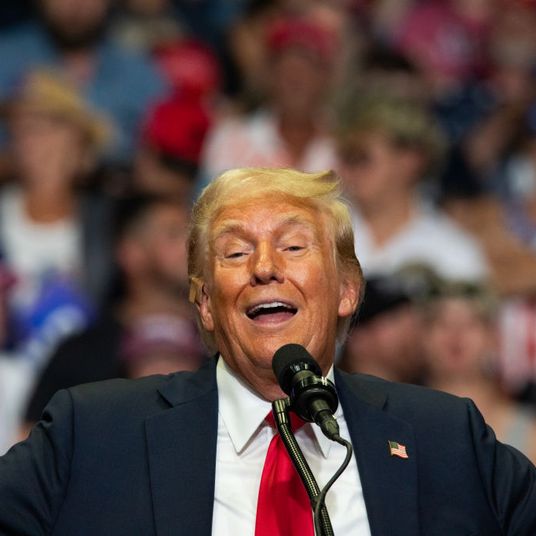
On September 12, Andy Constan, a bond trader and analyst with more than three decades of experience on Wall Street, made a bold prediction about the near-term future of money. In his view, a strong economy, coupled with the Federal Reserve’s high interest rates, would soon cause inflation to tumble. On a phone call a few days later, he told me he didn’t think the Fed would raise interest rates at its September meeting, but it probably would one more time for the end of the year, before cutting rates around halfway through 2024. Since his job is to make as much money as he can for himself and his clients, he made a super-specific recommendation: Buy Treasury debt that matures in two years, he said. Soon, they would be returning more money to investors than the money-market cash accounts that are yielding more than 5 percent a year, and with far less risk than the topsy-turvy stock market. (Around the time, two-year Treasury notes were yielding just under 5 percent.) He was mulling buying those bonds, maybe even borrowing money to do so, as soon as the next day, according to the tweet.
On Wednesday, the Fed did almost everything Constan predicted. It held interest rates steady. It published a report showing most central bank officials thought they would raise interest rates one more time this year. But he was off on one factor: The Fed expected to keep rates higher in 2024 than he predicted. That subtle difference blew up his thesis. “It was more hawkish than my expected case,” he said of the Fed’s 2024 predictions on Wednesday. “That’s signaling that interest rates are not going to collapse very much for a long time. That makes cash even more attractive, and stock and bonds even less attractive,” he said — including those two-years. While Constan decided against acting on his prediction and buying two-year bonds himself, anyone who took his advice and did would have been left holding securities that became less valuable immediately after the Fed meeting.
For more than a decade, the Fed was seen by Wall Street as an institution that would follow the markets’ lead — with central bank chairs Ben Bernanke and Janet Yellen going out of their way to tell bond traders exactly what they were thinking well ahead of time. During the years after the 2008 financial crisis, whenever the market didn’t like the Fed’s decisions, traders would crash a market until they got what they wanted (that is, the Fed following their preferred course of action).
Constan’s miss this week illustrates how that era is over — and how Wall Street is still grappling with that change. In this new phase, the Fed is less predictable and less agreeable from the perspective of your typical Wall Street investor. The central bank’s meeting on Wednesday sent financial markets of all sorts tumbling — imagine endless varieties of Constan’s story, with investors’ expectations collectively being thwarted in narrow but important ways. Spiking bond yields and volatile stock indexes since the meeting underline the extent to which all financial-market participants are on edge these days about the state of the economy, the direction of inflation, and how the Federal Reserve sees it all.
Predicting what the Fed is going to do is a notoriously perilous job, a few orders of magnitude more complicated than nailing the spread of the Super Bowl. As it should be — what’s at stake is all the money in the world. Since the Fed’s meeting, Wall Street has revisited its recent conventional wisdom about the strength of the economy, how high unemployment really could go, and how much longer inflation is really going to linger. Jerome Powell, the Fed’s chair, said that economic activity was stronger than expected, and he was ambivalent about a so-called “soft landing” scenario, where inflation is tamed without tanking the economy. The generally optimistic mood of late — hey, maybe we were going to avoid a recession after all — has been shaken. Wall Street began contemplating a future where rates stay higher for longer than the average analyst was expecting.
The disbelief was evident not only in the numbers flashing across bond traders’ Bloomberg terminal screens — the bond markets were going crazy — but also across the front page of The Wall Street Journal. In the immediate aftermath of the Fed’s meeting, the blaring headline on the top of its website was “Don’t Buy the Fed’s Rate Projections.” The column made a case for “investors think this is probably a bluff,” and the Fed is going to cut rates sooner than anticipated (which would look something like Constan’s original theory). It was basically a knee-jerk invocation of the less scary, more pliant Fed under Bernanke and Yellen.
But Wall Street didn’t buy it. By Thursday morning, the Journal’s front page had a very different headline near the top: “Higher Interest Rates Not Just for Longer, But Maybe Forever.” In the piece, Greg Ip, the paper’s economics columnist, argued that it is a bad idea to fight the Fed when it’s telling you where it wants to go.
Bond markets don’t have to move all that much in order to signal chaos. Treasury bonds are the largest single market on the planet, totaling about $26 trillion. It’s a world where even a couple tenths of a percentage point could translate into huge profits or losses. And one thing that bond investors absolutely do not mess around with is inflation. This has to do with how they work: Unlike stocks, there are two prices investors care about. There is the price of the bond, and there is the yield — so a one-year $100 bond with a 5 percent yield gives you back $105 when it matures. (The price and the yield move in opposite directions, so the less you pay for it, the more you get in return.) When inflation ticks up, bond investors demand more yield so their bonds don’t get eroded by a weakening dollar.
That’s why Wall Street dumped the bonds with impunity after the Fed said it was not satisfied with its work curbing inflation. The 10-year Treasury bond, a benchmark for mortgages and credit cards, rose to the highest point since 2007, from a yield of 4.31 percent on Wednesday to a high of 4.49 percent the day after. (A move that big, that fast, is unusual for the 10-year.) The 2-year bonds, the ones that Constan had bet on, are sensitive to short-term inflation, and they moved in a similar way. Since September 13, yields on 2-year bonds have climbed from 4.98 percent to 5.14 percent — reaching a high not seen since 2006. Bond prices dropped in proportion, of course.
The morning before the Fed meeting, Constan and I had gone over a few different scenarios about what the central bank might do, ranging from the least likely to the most. And the way it played out, he was pretty damn close. On the social-media platform X, he took an approach following the meeting that’s a bit more zen, or maybe buyer beware, compared to his message of the week before. “I look at all scenarios and am open to all of them occurring,” he wrote. “I place reasonable odds on each outcome and then compare them to the odds that are priced into markets. My edge isn’t about being right on the economy. Don’t much care about being right and mostly don’t know how the economy will turn out.” Of course, Constan is a pro and hedging his risks is second nature to him — one of the points of his original post was that bond traders don’t usually just buy and hold. For him, in a way, it was just another day in the bond markets, where everyone who has an idea of what’s coming next almost always misses some key part of the larger puzzle.
But the volatility in the bond markets following the Fed meeting suggest that it’s not quite business as usual in the big picture, as Wall Street tries to arrive at a new understanding of what the economy will look like — and how the Fed will act — next year and beyond.





























